My name is Troy Ryan Wood, and I have been a Whovian since November of 1983, when I caught my first glimpse of The Five Doctors during a early-evening showing of the 20th Anniversary special on our local KVIE Sacramento PBS affiliate. I'm afraid my poor mother had to spend so much time answering my curious questions about the Doctor, his friends, and enemies, that she had very little opportunity to watch the episode itself.
A few weeks later, I snuck out past my bedtime to catch a repeat of The Green Death, and what ensued from that point forward was a weekly battle of wills between myself and the television, wherein I would insist that I wasn't too scared or sleepy to stop watching, only to slink off back to bed after the adventure was over, terrified that giant venomous maggots, spiders, Drashigs, or Wirrn would crawl through my open window during the middle of the night and bite me if even an inch of my exposed flesh stuck out from underneath the covers.
It's the kind of lingering childhood trauma that made me the super-fan I am today.
|
Lacking any proper Doctor Who toys of my own growing up, I had to make do with my imagination and whatever I could cobble together from Lego and random bits of styrofoam and cardboard. (The image below is a Lego console room design I came up with in 2014. I'm afraid 7-year-old me's TARDIS was a lot more rectangular and rainbow colored with a green floor, and the Doctors were all portrayed by different color spacemen.)
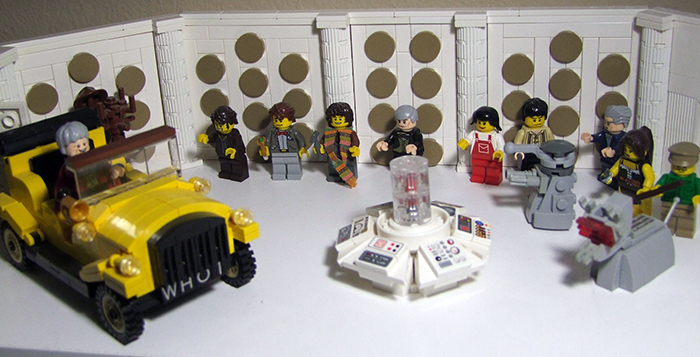
In 1989, as the 7th Doctor and Ace strode off into the sunset and the classic era of Doctor Who died a slow languorous death, Dapol released the first batch of figures I had access to in the United States.
Of course, I *begged* my parents to buy them for me the moment I saw them advertised in Doctor Who Magazine, but I was always disappointed by just how rubbish they looked compared to every other action figure you could get at the time. For their big 7th Doctor playset (which I never did manage to get), they couldn't even be bothered to check how many sides the TARDIS console was supposed to have. The nerve of some people!
Even at age 11, I knew we deserved better than this.
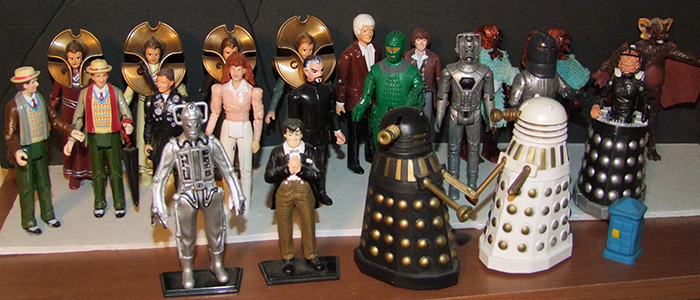
Then, over a decade later, my childhood entreaties were finally answered.
First, with the magnificent Product Enterprise 6" to 12" talking Daleks, Cybermen, and 4th Doctor/K9 sets, and then a few years later, hot on the heels of the Doctor's miraculous return to television in 2005, with Character Options' glorious 5.5" scale range of toys, which I've been an avid collector of ever since.
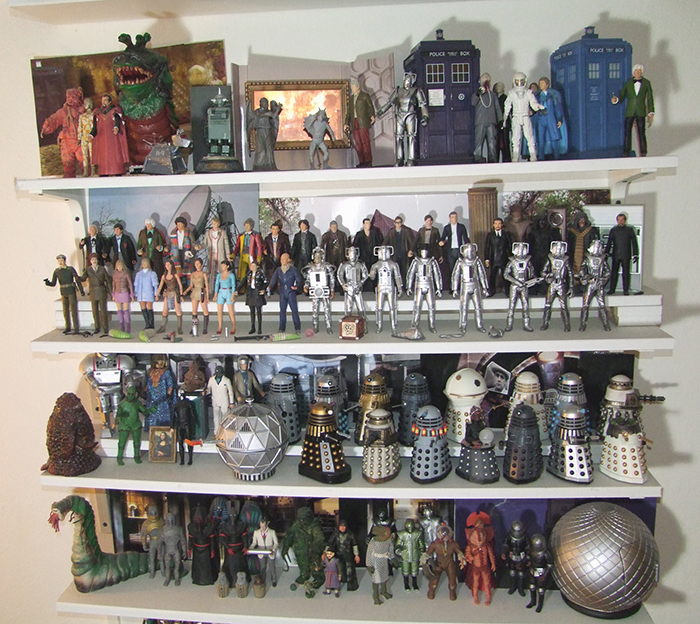

The 3D Printing Doctor Who project officially started in 2017 while I was attempting to build the interior workings of a spring-loaded Auton hand for an upcoming Doctor Who event, and just happened to mention to the right person at the right time that I wasn't having much luck assembling the stupid contraption out of wood.
He recommended that I check out the new 3D printer that had recently been added to our local library, as well as an extremely simple 3D modeling tool called TinkerCAD, that I could use to recreate my Auton mechanism (appropriately enough) entirely out of plastic.
Lacking any better options, I decided to give it a shot, and in the process of building the hand, I also created my first two figures, Alpha Centauri and a Quark, which came together over the course of just a few days using nothing but the stock geometric shapes native to TinkerCAD. After that, I was hooked, and immediately saw the potential for creating all sorts of new figures that weren't currently available in the official 5.5" toy range.
I reasoned that if I could create just ten more figures, then the cost of purchasing my own printer and a few rolls of filament to get myself started would be more or less equal to the same amount of money that I'd have forked out buying the same figures at a store.
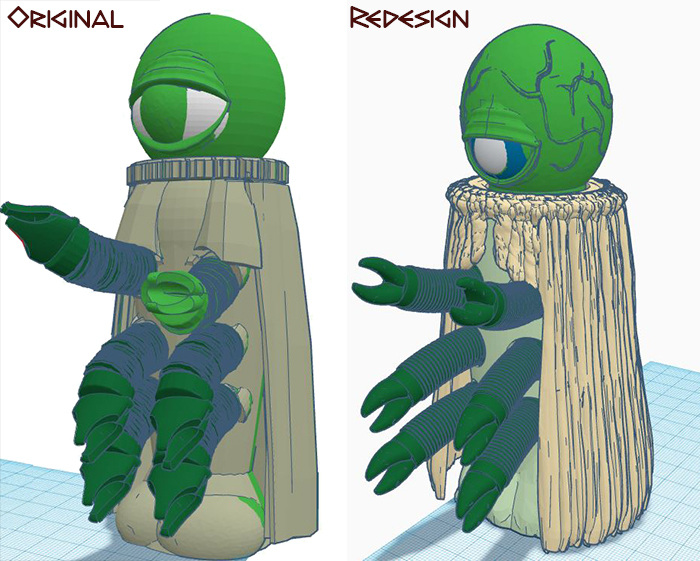
My first few creations were pretty rough and hampered by TinkerCAD's overly-simplistic shape selection and lack of sculpting tools, but it didn't take long for me to discover that the program had a import feature that would allow me to upload more complicated shapes and textures snipped from other people's models that could then be trimmed and "kitbashed" together to form more complex organic structures. (For example, my Yeti figure is composed almost entirely of chunks taken from this rat.) By the time I reached my 21st figure, I had also begun using the free sculpting tool MeshMixer to export TinkerCAD's extremely angular geometric shapes and manipulate them directly. This flip-flopping between TinkerCAD and MeshMixer is still how I assemble the majority of my figures today.
In early 2018, I began adding LED light brick and motor compatibility to some of my designs, allowing me to build a whole new range of deluxe figures that could light up and/or be driven around. By 2019, the cost of resin printers had dropped to the point that you could now pick one up for around £200 (less than the cost of a standard FDM printer) allowing me to up my game considerably and produce improved figures with nearly the same level of surface detail as those officially released by Character Options.
Around the same time,
interest in my pet project really started to take off, and the 3D Printing Doctor Who Facebook Group I initially started as a means of showcasing my own work ballooned to over 1000 members, some of whom started contributing their own 3D printable models to the mix. As of 2020, we now have several talented artists contributing designs on a regular basis and the project has essentially morphed into a colaborative effort, with myself as just one creator among many.
|
3D printing technology continues to advance in leaps and bounds, and as it does, the previous generation of printers become cheaper and more accessible to home consumers. Printers that once cost thousands of pounds can now be obtained for only a few hundred, and resin printers in particular are growing larger, safer, and more comparable in size to their filament counterparts.
There are figures that I can create today that would have been impossible just three years ago. As of right now, the biggest limiting factor on what sort of figures I can produce isn't technological, but rather, my own skill as a sculpter.
With a reasonably high quality resin printer and a sufficiently detailed model, technically speaking, we should be able to create figures for every single actor who ever set foot on a Doctor Who sound stage... The hard part is finding someone skilled enough to create all those models from scratch who is willing to offer up their services for free.
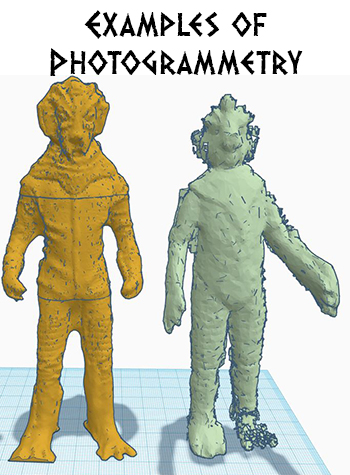
3D scanning and photogrammetry (the scanning of physical objects and creating meshes automatically from a patchwork of still images) are the next two big areas that I think will have a significant impact on where this project heads in the future. Currently, both techniques are still in their infancy, but what once took an entire room of highly specialized equipment, can now be done with an Xbox One Kinect Sensor and the right kind of software.
Possibly by the time I finish all the figures on my lengthy to-do list, both areas will have improved to the point where I can simply feed an old black and white clip of a 1960's Doctor Who episode into my computer, and through the magic of machine learning it will effortlessly render a gorgeous Koquillion mask with no clean-up or worrying about random floating polygons on my part. |